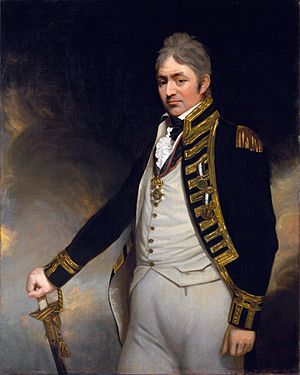Sir Thomas Troubridge, 1st Baronet facts for kids
Quick facts for kids
Sir Thomas Troubridge, 1st Baronet
|
|
|---|---|

Troubridge as a rear-admiral, painted 1804-5 by Sir William Beechey
|
|
| Born | 22 June 1757 London |
| Died | 1 February 1807 Aboard HMS Blenheim |
| Allegiance | United Kingdom of Great Britain and Ireland |
| Service/ |
Royal Navy |
| Years of service | 1773–1807 |
| Rank | Rear-admiral |
| Commands held | HMS Chaser HMS Lizard HMS Active HMS Defence HMS Sultan HMS Thames HMS Castor HMS Culloden |
| Battles/wars | American War of Independence |
| Awards | Order of Saint Ferdinand and of Merit Naval Gold Medal |
| Relations | Edward Thomas Troubridge (son) |
Sir Thomas Troubridge (born June 22, 1757 – died February 1, 1807) was a brave officer in the Royal Navy. He started his career as a junior officer and fought in important battles like the Battle of Sadras and the Battle of Trincomalee during the American Revolutionary War. Later, he commanded a large warship called Culloden at the famous Battle of Cape St Vincent. He became a very important naval leader, serving as First Naval Lord and then as the main commander in the East Indies during the Napoleonic Wars.
Contents

Thomas Troubridge was born in London. His father was a baker. He went to St Paul's School before joining the Royal Navy on October 8, 1773. He served alongside another famous naval hero, Horatio Nelson, on a ship called HMS Seahorse in the East Indies.
He became a lieutenant on January 1, 1781. He then returned to the Seahorse and took part in the Battle of Sadras in February 1782 and the Battle of Trincomalee in September 1782. These battles were part of the American Revolutionary War and the Anglo-French War. His first time commanding a ship was in October 1782, when he led the small warship Lizard .
Rising Through the Ranks
Troubridge was promoted to post-captain on January 1, 1783. This meant he was now in charge of a frigate, Active . He was present at the Siege of Cuddalore in June 1783. After this, he moved to a larger ship, Defence . In 1785, he sailed back to England on Sultan. He was the flag-captain for Admiral Sir Edward Hughes, meaning he was the captain of the admiral's main ship. In 1790, he was given command of the frigate HMS Thames.
Leading in Major Conflicts
In May 1794, Troubridge was put in charge of the frigate Castor . While protecting a group of merchant ships, he and his ship were captured by the French. However, he was freed soon after. When he returned, he was given command of Culloden . This was a powerful ship of the line.
He fought in the Battle of the Hyères Islands and led a chase after a French fleet in the Aegean Sea. He was especially brave at the Battle of Cape St Vincent. Admiral Sir John Jervis praised him for his courage and quick thinking.
In July 1797, Troubridge helped Nelson in an attack on Santa Cruz de Tenerife, which was not successful. In August 1798, his ship Culloden ran aground on a sandbank near Aboukir Bay. Because of this, he could not join the Battle of the Nile. Even so, Nelson asked for Troubridge to receive a special gold medal to celebrate the victory.
Later Career and Tragic End
Troubridge continued to serve in the Mediterranean Sea. He was given the special title of baronet on November 30, 1799. In February 1801, he joined the Board of Admiralty as First Naval Lord. This meant he was one of the most important leaders in the Royal Navy.
On April 21, 1804, he was promoted to rear-admiral. He was then sent to command the eastern part of the East Indies Station. He sailed on Blenheim. His role on the Admiralty Board ended in May 1804.
When he arrived, his command area changed to the Cape Station. In January 1807, he left Madras heading for the Cape of Good Hope. Off the coast of Madagascar, his ship Blenheim was caught in a powerful cyclone. The ship was old and damaged, and it sank. Admiral Troubridge and everyone else on board were lost at sea.

